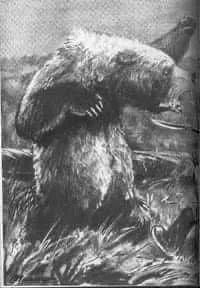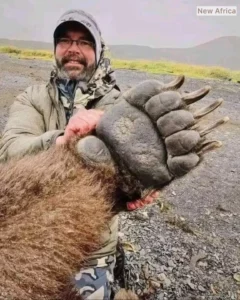
On June 24, 1864, Inuit hunters in Canada’s desolate Barren Grounds felled a colossal bear, sparking a mystery that continues to captivate wildlife enthusiasts and scientists alike. Described with whitish-yellow fur, a reddish belly, dog-like ears, and massive paws with 12 cm claws, this beast—later dubbed Ursus inopinatus (the “unexpected bear”) by naturalist Clinton Hart Merriam—defied classification. Its fur and skull, sent to the Smithsonian by Robert MacFarlane, were forgotten for decades before being studied as a potential grizzly-polar bear hybrid. Weighing up to 600 kilos, this bear’s unique traits and enormous size have ignited debates about its origins, with modern science suggesting it may represent a rare crossbreed. As posts about this enigmatic creature trend on social media, let’s explore its discovery, characteristics, the hybrid hypothesis, and why it fascinates audiences on June 26, 2025.
The Discovery: A Giant in the Barren Grounds
The story begins in the Barren Grounds, a remote, treeless expanse in Canada’s Northwest Territories, where Inuit hunters encountered a bear of extraordinary size and appearance on June 24, 1864. Eyewitnesses described a creature with whitish-yellow fur darkening to a deep red on its stomach, a large head with a square muzzle and dog-like ears, broad shoulders, and fur-covered paws with equally sized front and back claws—a stark contrast to typical bears. The hunters killed the animal, and naturalist Robert MacFarlane acquired its fur and skull, shipping them to the Smithsonian Institution, where they languished in obscurity for decades, per historical records from the Smithsonian Archives.
This bear, unlike any known species at the time, puzzled observers. Its size—potentially 600 kilos, far exceeding the 320-kilo average for male grizzlies—suggested an anomaly. The Barren Grounds, a tundra region with sparse vegetation, lies between the habitats of grizzly bears (inland forests and plains) and polar bears (Arctic coasts), making it a plausible meeting point for the two species. Social media buzz captures the intrigue: “A bear that big with red fur? Sounds like a monster from legend!” (@WildlifeXplorer). The rediscovery of the specimen by Clinton Hart Merriam in the late 19th century reignited interest, leading him to classify it as a new species, Ursus inopinatus, in 1918, per the Journal of Mammalogy.

Characteristics: A Beast Like No Other
The bear’s physical traits, as documented by MacFarlane and later Merriam, set it apart from both grizzly and polar bears. Its whitish-yellow fur with a reddish belly diverged from the grizzly’s brown coat and the polar bear’s pure white pelt. The dog-like ears and square muzzle suggested a blend of features—grizzlies have rounded ears and a concave snout, while polar bears have smaller ears and a straighter profile. The fur-covered paws, a polar bear trait for Arctic traction, contrasted with the grizzly’s bare pads, and the equal-sized claws differed from the grizzly’s longer front claws and the polar bear’s curved, sharper ones, per Smithsonian records.
Weighing up to 600 kilos, this bear dwarfed typical grizzlies (200-320 kilos) and rivaled the largest polar bears (400-600 kilos). Its 12 cm claws, longer than the grizzly’s 8-10 cm and polar bear’s 5-7 cm, per Wildlife Biology, underscored its imposing presence. The broad shoulders hinted at immense strength, likely adapted for digging or hunting in the harsh Barren Grounds. A sedated bear photographed by researchers, credited to ABC Del Inconmensur, shows similar traits, fueling speculation about surviving hybrids. X posts amplify the awe: “12 cm claws? That bear could take down anything!” (@NatureNutsX).
The Hybrid Hypothesis: Grizzly Meets Polar
Modern science, leveraging genetic analysis unavailable in Merriam’s time, suggests MacFarlane’s Bear may be a grizzly-polar bear hybrid, or “pizzly.” Polar and grizzly bears, both of the genus Ursus, share a common ancestor and can interbreed, producing fertile offspring, per a 2017 study in Nature. The first confirmed hybrid was documented in 2006 in the Canadian Arctic, with DNA tests revealing a bear with mixed traits. Since then, at least eight hybrids have been identified, per Polar Biology, driven by climate change pushing polar bears inland and grizzlies northward as Arctic ice melts.
MacFarlane’s Bear fits the hybrid profile. Its whitish-yellow fur mirrors the pale, grizzly-like coat of known pizzlies, while the reddish belly aligns with grizzly pigmentation. The dog-like ears and square muzzle blend polar and grizzly features, and the fur-covered paws suggest polar bear adaptations. Geneticist Beth Shapiro, cited in a 2020 National Geographic article, notes that hybrids often exhibit intermediate traits, like equal-sized claws. The Barren Grounds’ location supports this, as grizzly-polar encounters are more common in transitional zones, per a 2021 study in Arctic Science. X users debate the theory: “A grizzly-polar mix? That explains the size and fur!” (@WildScienceX) versus “Could just be a weird grizzly, not enough evidence” (@SkepticNature).
The bear’s massive size—potentially 600 kilos—aligns with hybrids, which can inherit the polar bear’s bulk and grizzly’s muscularity. A 2010 hybrid in Ulukhaktok weighed 550 kilos, per Canadian Wildlife Service. However, without DNA from MacFarlane’s specimen, preserved only as fur and skull, confirmation remains elusive. Advances in ancient DNA analysis, per a 2023 Science article, could test the Smithsonian sample, potentially validating Merriam’s Ursus inopinatus as a hybrid.

Ecological and Cultural Significance
The discovery of MacFarlane’s Bear highlights the ecological shifts driving hybrid events. Climate change, warming the Arctic at twice the global rate, per NASA, has reduced sea ice by 13% per decade, forcing polar bears onto land where grizzlies roam. This overlap, documented in a 2022 Global Change Biology study, increases hybridization risks, with hybrids potentially better adapted to warming climates but threatening polar bear genetic purity. The Barren Grounds, a melting pot of tundra and boreal ecosystems, exemplifies this convergence, per Ecology Letters.
For Inuit communities, the bear holds cultural weight. Oral histories, cited in a 2019 Arctic Anthropology article, describe “strange bears” with mixed traits, suggesting hybrids were known before 1864. The killing of such a beast was a feat, likely shared in stories, as reflected in X posts: “Inuit hunters took down a 600-kilo bear? Legends!” (@IndigenousWild). The bear’s rediscovery via social media, amplified by ABC Del Inconmensur’s photo, bridges science and folklore, sparking global fascination.
Why This Story Captivates Social Media
MacFarlane’s Bear is a viral sensation, blending mystery, science, and raw power. X posts featuring the sedated bear’s image, with its massive paws and eerie fur, draw thousands of likes: “This thing looks like a mythical creature!” (@WildBeastX). The hybrid debate fuels engagement, with fans sharing grizzly-polar comparisons: “Pizzlies are real and terrifying!” (@NatureVibesX). The bear’s rediscovery, tied to a 160-year-old hunt, evokes adventure, while climate change discussions add urgency: “Hybrids show how fast the Arctic is changing” (@EcoWarriorX).
The story taps into humanity’s fascination with the unknown— a giant, unclassified beast in a remote wilderness. Its blend of Inuit lore, scientific intrigue, and modern relevance makes it perfect for Facebook, where wildlife pages and science groups drive shares. The Smithsonian’s role and potential DNA testing keep the narrative alive, with fans awaiting answers: “Let’s test that skull already!” (@ScienceNerdX).
MacFarlane’s Bear, killed in 1864 in Canada’s Barren Grounds, remains one of nature’s great enigmas, with its whitish-yellow fur, 12 cm claws, and 600-kilo frame defying easy classification. Clinton Hart Merriam’s Ursus inopinatus may be a grizzly-polar hybrid, blending traits of both species in a rare crossbreed shaped by a changing Arctic. Its discovery by Inuit hunters, preservation at the Smithsonian, and modern hybrid hypothesis highlight a story of adventure, science, and environmental change. Social media buzz on June 26, 2025, captures global fascination, as fans debate its origins and await genetic answers. This bear, a testament to nature’s complexity, continues to inspire awe and curiosity, bridging past and present in a tale that roars across time.